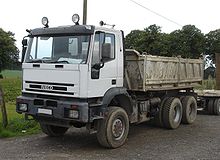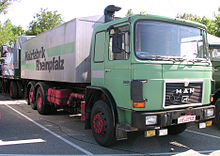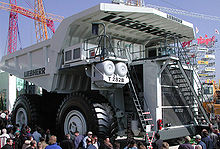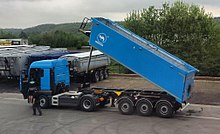Tipping bridge (loading area)




A tipping bridge is a special form of construction of commercial vehicles or trucks . Vehicles with tipping bridges are generally referred to as tipper vehicles. Due to their design, they are used to transport pourable and / or pourable goods such as B. earth or sand . Another use is the so-called Meiller car , which makes it possible to transport a rocket in a lying position in order to then set it up again at the launch site.
Construction and use
The tipping bridge is a loading surface connected to the chassis of the carrier vehicle via a tilting mechanism, which can be tilted by actuating this mechanism and thus causes unloading by deliberately sliding the load off the loading surface. The loading area of the tipping bridge is mostly flat (exception: some rear tippers, see below) and has a fixed side wall towards the front of the driver's cab. Versions of the tipping bridges are:
- One-way tipper
- With these, the load can only be tipped in the direction required by the design. The tilting mechanism can then only be operated in this direction and the side walls of the other sides are permanently installed. The shape that is common today is the rear tipper, which can only be tipped against the direction of travel. There are also rounded loading areas on the inside to prevent residual cargo from getting stuck when tipping. This is today partly for solo vehicles, but especially at tilt semitrailers and dump trucks to find
- Two-way tipper
- These can be tilted to the right and left. The tilting mechanism is intended for these two tilting directions, the rear wall in this case mostly fixed (this type of construction is rather uncommon today)
- Three-way tipper
- With these, except for the front wall, all side walls are designed to be movable and the tilting mechanism can also be operated to the right and left as well as to the rear. Today, this is mainly found in solo vehicles and trailer trains and is the design common today.
Tipper vehicles for public transport are mostly used in the construction industry, and often in public areas such as B. from road maintenance depots or green space offices. In the field of agriculture, grain tippers are often used as a special form, which usually have a closed structure or tarpaulin to protect the load from the weather.
The range of carrier vehicles begins with small vans and extends to oversized dump trucks, which are used in large opencast mines in many countries and can weigh in the range of several hundred tons. Due to their size, the latter are not suitable for use on public roads. In road traffic, tipping bridges are commonly used on all common truck chassis, with heavy vehicles often using semi-trailers with trailers and tipping bridges built on them. In agriculture are spread tractor vehicle trailer with tipping body ( "Rubber car"), for example, take up the crop from the harvesting machinery during harvest time (z. B. grains, sugar beets or potatoes) and then tilt it to the intended storage or processing site again can.
history
In the first decades of commercial vehicle construction, the tilting mechanisms were caused by physical force, e.g. B. by cranks to operate. Later on, tilt drives operated by air pressure and moved by hydraulic fluid were added, which are now the standard. The tipping mechanisms can be installed between the driver's cab and the tipping body on the rear tipper; on the others, due to the design, they are always located under the loading area.
Like most other commercial vehicle bodies, tipping bridges were initially mainly made of wood and only fitted with metal fittings. Since the 1960s, wooden structures have increasingly been replaced by metal ones. In addition to the steel structures that have dominated for a long time, those made of light metal such as B. to find aluminum .
